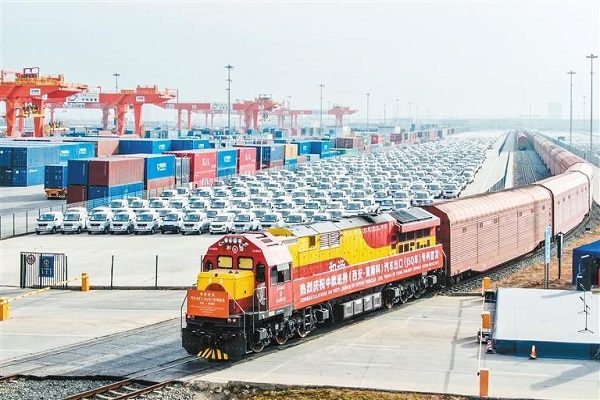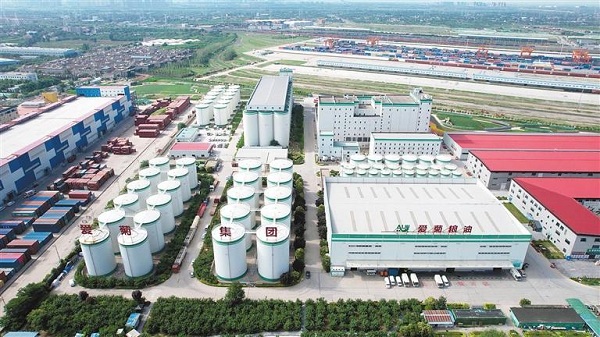
A China-Europe Chang'an freight train departs from Xi'an. [Photo/Xi'an Daily]
In the past decade, the China-Europe Chang'an freight train has expanded its trunk route from just one to 17, connecting 45 countries and regions across Eurasia.
It has born witness to Xi'an's deep integration into the Belt and Road Initiative (BRI).
Facilitating trade
"Thanks to the freight train, our company can import grains from Kazakhstan in less than a week," said Liu Dongmeng, deputy general manager of Xi'an Aiju Grain and Oil Industrial Group.
At Aiju Group's warehouse in the Xi'an International Trade and Logistics (ITL) Park, one-third of grain and oil products come from Kazakhstan.
Relying on the freight train, Aiju Group has gradually built a trilateral cross-border logistics and processing system between Northern Kazakhstan, the Alashankou Port in Xinjiang, and the ITL Park.

An aerial view of Xi'an Aiju Grain and Oil Industrial Group. [Photo/Xi'an Daily]
This has established a smooth logistics supply chain between China and countries involved in the BRI, especially Central Asian countries.
The freight train also facilitates the export of Xi'an-manufactured products, like new energy vehicles and photovoltaic components, to overseas destinations.
Forming an international trade and logistics hub
The ITL Park has strengthened cooperation with other provinces and cities. Other cities operate fixed train lines to Xi'an, where the goods gather and then board the freight train to sail abroad.
The freight train has expanded such reach to 21 routes, covering 23 provinces. It has achieved interconnectivity with regions such as the Yangtze River Delta, Pearl River Delta, and Beijing-Tianjin-Hebei region. Cities in Shaanxi province, such as Yulin, Weinan, Hanzhong, and Baoji, have established partnerships with the freight train.
An international trade and logistics hub combining container transportation, cold-chain logistics, futures delivery, bulk commodities, and vehicle transportation is now rapidly taking shape.
Gathering related industries
Leveraging its advantages in efficiency, costs, and services, the freight train has driven numerous industries, including import-export processing and cross-border e-commerce, to cluster and develop, thereby spurring economic growth in landlocked Xi'an.

A foreign host introduces Chinese products to overseas customers in the livestream room of the Belt and Road E-commerce Center in ITL Park. [Photo/Xi'an Daily]
Capitalizing on the logistical advantages of the freight train, the Belt and Road E-commerce Center in ITL Park has integrated livestreaming e-commerce, cross-border livestreaming, short video production, and host training.
The ITL Park has attracted well-known domestic and foreign cross-border e-commerce platforms, along with their upstream and downstream enterprises. More than 2,500 e-commerce and related companies have registered, with over 5,000 e-commerce professionals gathered.